Galleries
11 Young Art Dealers Who Are Revitalizing Their Art Scenes
Smaller galleries may be under pressure, but these inspiration figures are forging ahead.
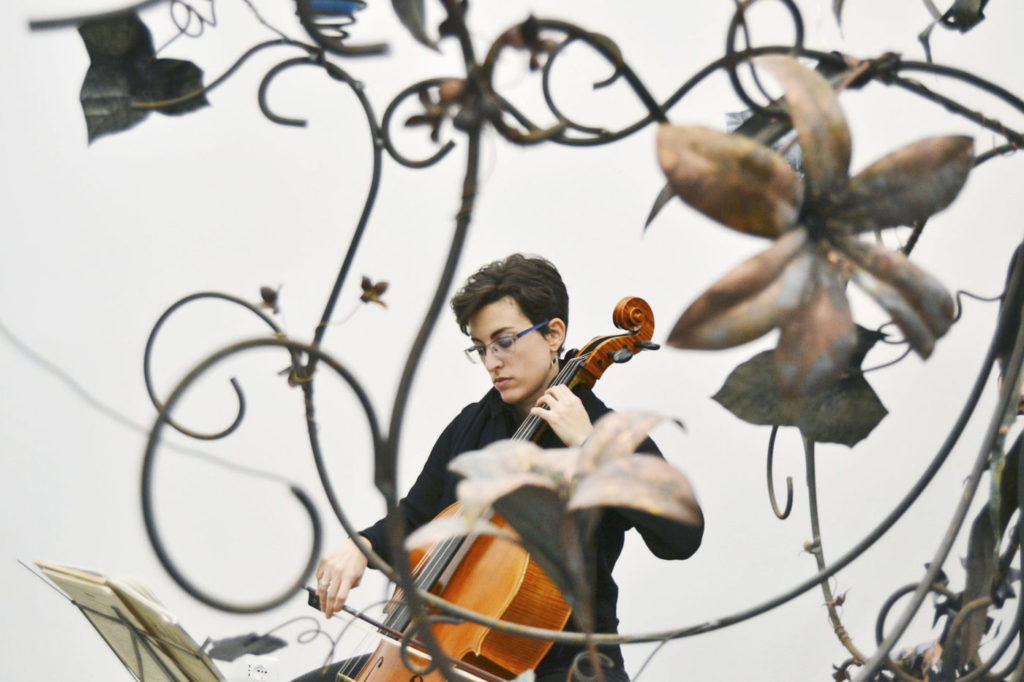
Smaller galleries may be under pressure, but these inspiration figures are forging ahead.

Small and mid-size galleries may be facing unprecedented pressures, but don’t tell that to these young dealers. From Paris to Prishtina, these plucky young gallerists are making bricks and mortar work for them by engaging in new kinds of collaboration, setting up shop in unorthodox locations, and using their spaces as platforms for local artists who have not previously gotten much international attention.
Below, meet 10 dealers in hubs both old and new who are helping to transform the art scenes around them.
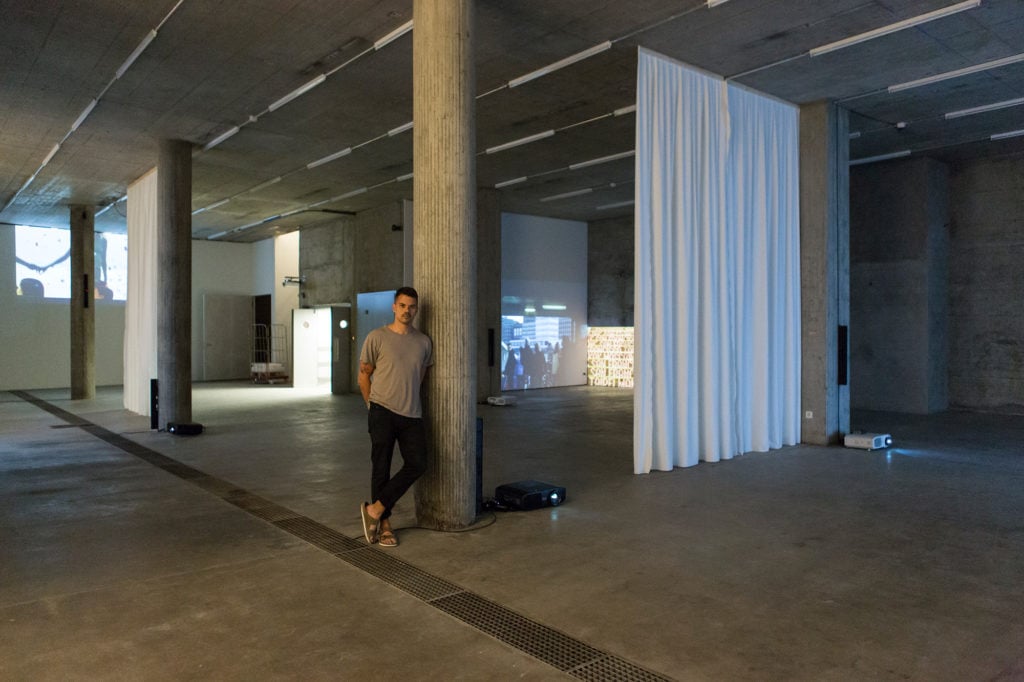
Jean-Claude Freymond-Guth inside his subterranean gallery in Basel. Photo by Nils Fisc, courtesy the gallery.
In June 2016, artist-turned-collector-turned-dealer Jean-Claude Freymond-Guth relocated his gallery from Zurich to Basel just in time for Art Basel—and into a location a stone’s throw away from the fair, too. The move meant a transfusion of fresh blood for the local gallery scene. With the exception of one week a year, the city on the Rhine is not exactly known as a hotspot for young, contemporary art.
“Basel has a unique tradition in building collections and philanthropy,” Freymond-Guth explains, “but is also home to some of Switzerland’s most dynamic institutions, such as the Kunsthalle with curator Elena Filipovic, or the art school headed by Chus Martinez.”
One year on, the gallerist, whose exciting roster is filled with video and installation artists, does not regret the move. “The proximity to the fair and the incredible space made the opportunities complete,” he says, referring to the subterranean, 800-square-meter concrete space refurbished by the Herzog & de Meuron. “Oh, and Basel is just absolutely beautiful to live in,” he adds.
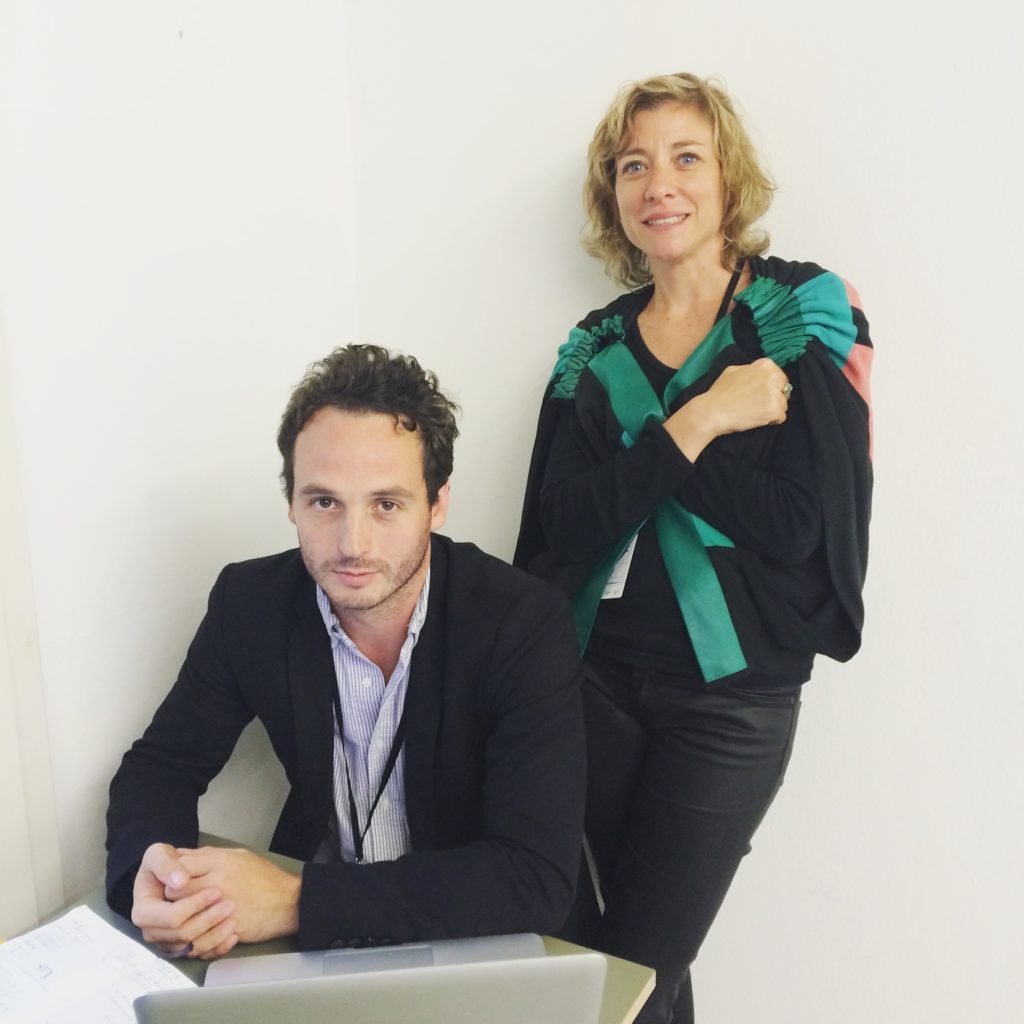
Axel Dibie and Alix Dionot-Morani, courtesy of Crèvecoeur, Paris.
Paris’s trendy Galerie Crèvecoeur was founded in 2009 by Axel Dibie and Alix Dionot-Morani after they met studying politics and art history at the prestigious Sciences Po. Eager for Crèvecoeur to break into the circuit, the upstart duo settled into a gallery space in the historic Belleville neighborhood, a hive of emerging galleries with a diverse cast of inhabitants. The young gallerists now support a program of French and international artists in the naturally lit 160-square-meter space on Rue des Cascades.
“For us, it is essential to develop a strong and resolutely international artistic program, presenting audacious foreign artists in France (such as Than Hussein Clark and Shana Moulton) and defending French artists who have already influenced a very young generation (like Renaud Jerez, whose work has been shown more in Germany and in the United States than in France),” Dionot-Morani writes to artnet News.
The pair will open a new gallery space in downtown Marseilles at the end of August, a move which will offer greater freedom to their program, though Dionot-Morani admits that it “goes a little against the current of the Paris-London-Berlin-New York axis.”
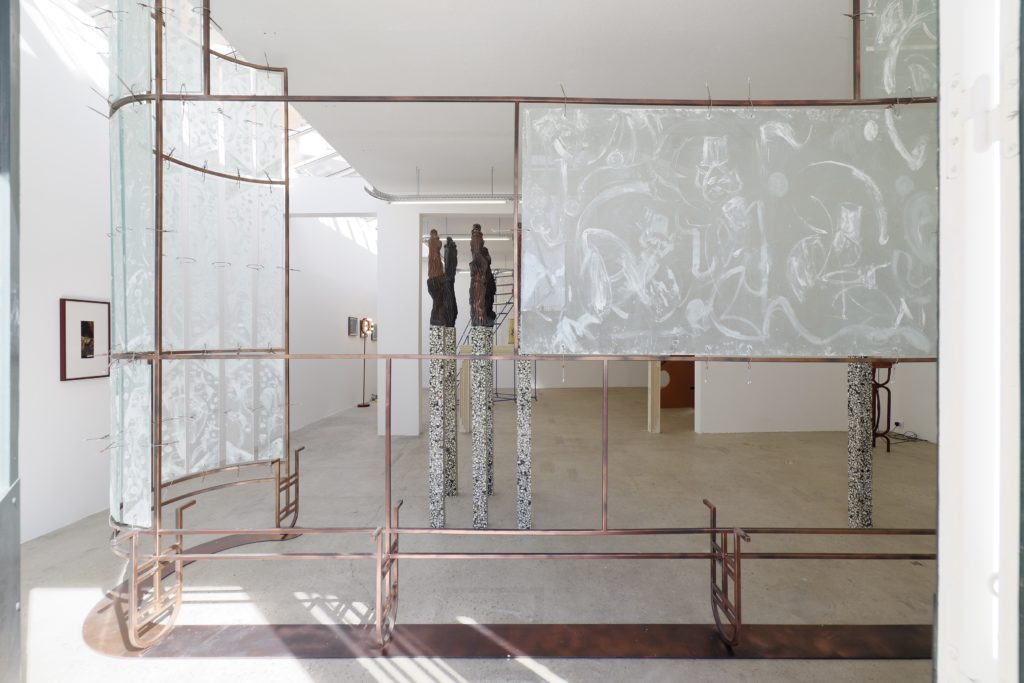
Than Hussein Clark, Hollywood Regency (2017). Exhibition view, Crèvecoeur, Paris. Photo: © Aurélien Mole, courtesy of the artist and Crèvecoeur, Paris.
Founded by curator Oliver Martínez Kandt in the town of Oaxaca in the South of Mexico, the small commercial gallery showcases a solid program of Mexican and international artists including names such as Jennifer Marman, Puppies Puppies, and Sergio Gutierrez.
As one of the few commercial art spaces in the city that showed at international fairs (such as NADA Miami and Material Art Fair), Parallel Oaxaca has served as an important platform for local artists on the international stage.
As its following and audience increased, so did its need to expand, and in 2016 the gallery opened a second space in the nation’s vibrant capital of Mexico City to increase its exposure and reach to a larger audience than in the small town of 300,000 where it originated. Mexico City boasts one of the world’s most vibrant and exciting art scenes, but the gallery has stirred up things up with its daring program.
When Scotland-born James Gardner opened Frutta gallery in the heart of Rome in 2012, he immediately caused a stir. At only 25 years old, his witty and sparse exhibitions quickly garnered attention from local and international audiences. With a roster of artists ranging in age, nationality, and media, the gallery’s signature is its disavowal of anything reminiscent of consistency. The model is clearly working so far, as Gardner tells artnet News he plans to open a second space in his native Glasgow next April.
The inaugural show in 2012, “The Problem of the Museum,” was a group show that began with a “discursive ambulation,” where the artists led visitors on a circuitous stroll around the neighborhood, ending at a local bar. The current show, “If the Sea Was Whiskey” is the first solo exhibition of painter Dickon Drury, whose mammoth canvases are trippy, whimsical works that—according to the press release—are intended to conjure a broad swath of utopian ideals: referencing both the unspoiled Arcadia of Ancient Greek mythology, and simultaneously the Americana folk song that lends its name to the show’s title, imagining “if the see was whiskey and I was a diving duck / I’d dive to the bottom and I don’t know if I’d come up.”
The juxtaposition of the sacred and profane, injecting the often hermetic white-walled gallery setting with acerbic humor, seems to be the moda operandi of Gardner. Those making a pit stop in Rome should make a point to visit the gallery.
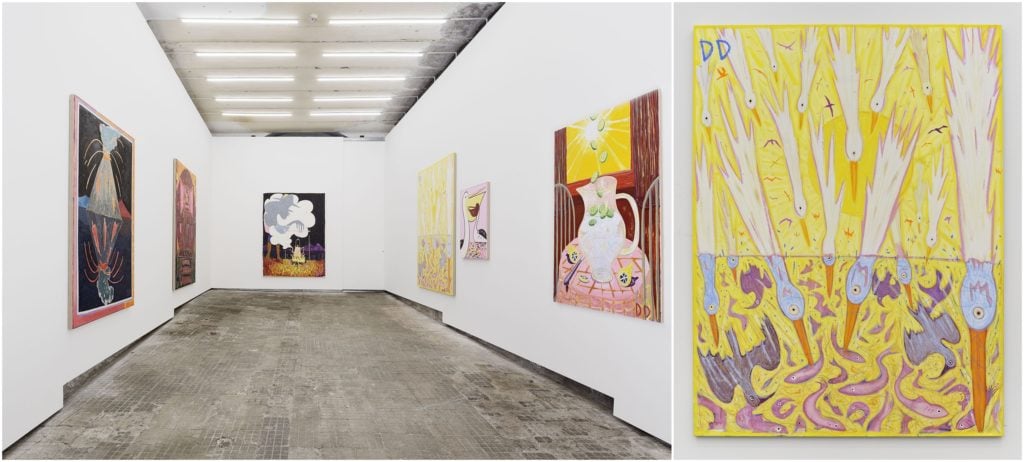
Installation view of Dickon Drury’s “If the Sea Was Whiskey” 2017, and Drury’s Bait Ball (2017). Photos by Roberto Apa, images courtesy of Frutta, Rome.
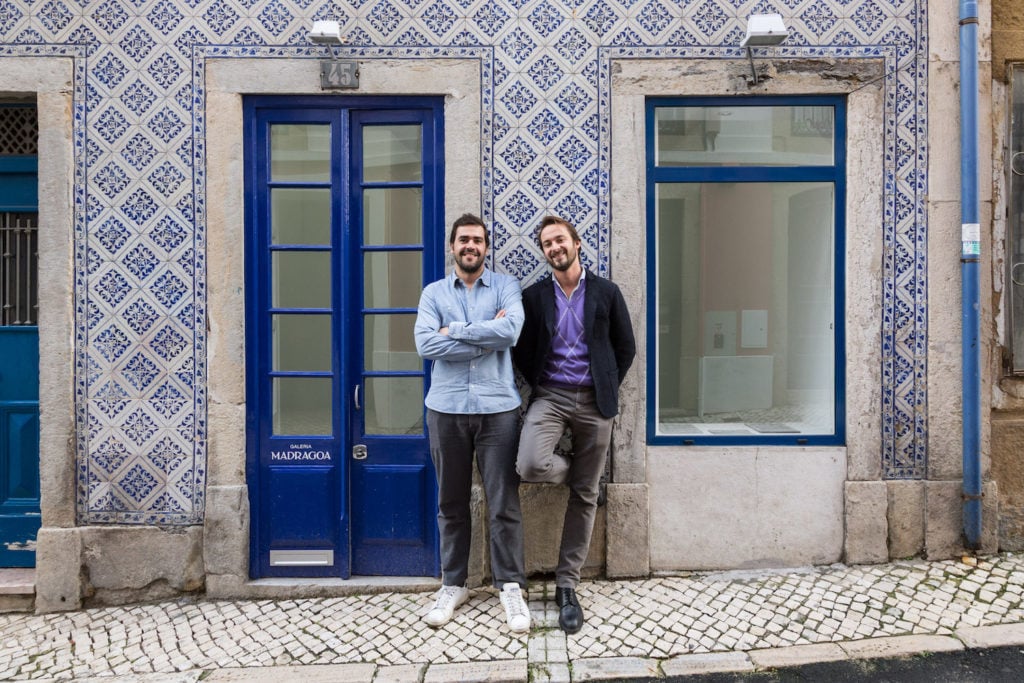
Madragoa’s founders and directors Matteo Consonni (right) and Gonçalo Jesus (left). Courtesy the gallery.
If someone can be credited with shaking things up in the Lisbon gallery scene, it’s 32-year-old Matteo Consonni, who arrived in the Portuguese capital in April last year to open Madragoa with partner Gonçalo Jesus, starting a veritable trend. Madragoa’s opening in April last year came a month before the first edition of the ARCOlisboa fair last year, while this year’s edition of the fair has coincided with the opening of three new commercial galleries—Galeria Francisco Fino, and the Lisbon outposts of Madrid’s MaisterraValbuena and Rome’s Monitor—quite an influx for the heretofore sleepy city.
Located between the city’s Barrio Alto and the new MAAT museum, one of the strengths of Madragoa’s program is its ability to transform and reinvent its small space with ambitious and refreshing exhibitions by young and emerging artists like Rodrigo Hernandez, Luis Lazaro Matos, and Joanna Piotrowska, among others. Besides a knack for the experimental, Consonni brings a wealth of commercial experience to the project (he was director of Turin’s blue chip gallery Franco Noero for five years). Their art fair participations are also going extremely well: In just over a year have taken part in Liste, ARCOmadrid, ARCOlisboa, SP Arte, Art-o-Rama, Grand Palazzo, Artissima, and Zona Maco (winning stand prizes in the last two).

Installation view of Rodrigo Hernández’s “Plasma” exhibition at Galería Madragoa, Lisbon. Courtesy the artist and the gallery.
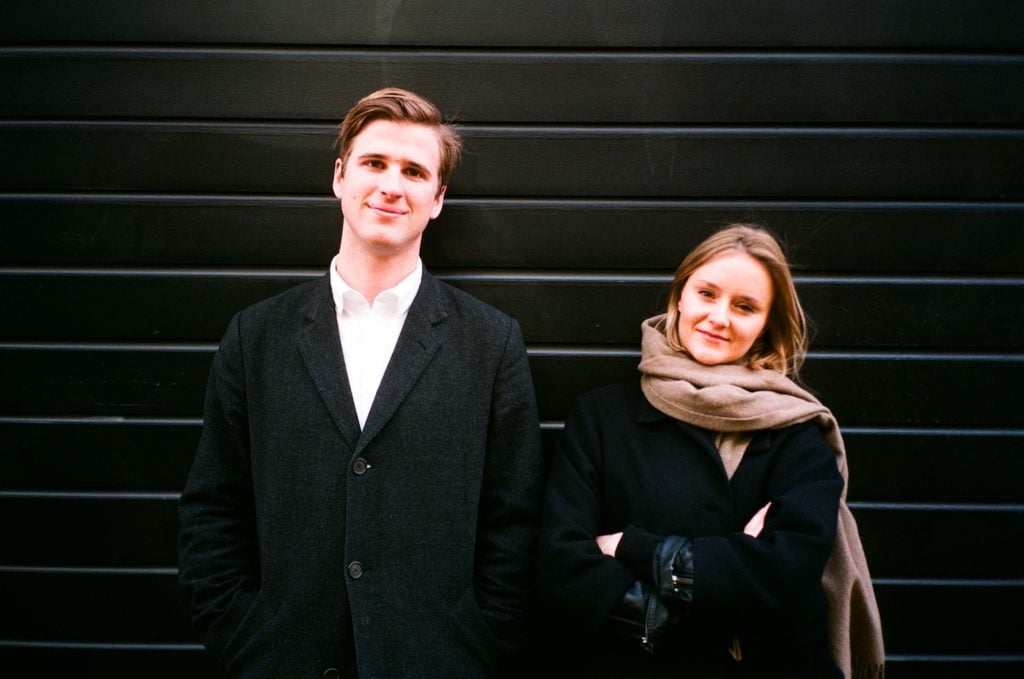
Emalin’s founders and directors Leopold Thun and Angelina Volk. Courtesy the gallery.
The friends Angelina Volk and Leopold Thun met at university in Scotland and began organizing itinerant exhibitions under the name of Emalin when they moved to London in 2014. In two years, the fledgling dealers, now in their mid-20s, organized nine exhibitions in unexpected locations, ranging from an abandoned 17th-century church in Naples to a suite of a London’s hotel. Through these exhibitions they began collaborating with some of the six artists whom they now represent, including Canadian Goldsmiths graduates Athena Papadopoulos and Nicholas Cheveldave; the American performance artist Kembra Pfahler, who achieved cult status in 1980s New York; and Lithuanian artist Augustas Serapinas.
In September 2016 Emalin opened a permanent space in Shoreditch, which coincided with the gallery’s debut at Frieze Art Fair as part of its “Live” section. The gallery has also participated in the 2016 edition of MiArt and in this year’s edition of Liste. Later this year they will be taking part in the “Focus” section of Frieze with a solo presentation of Evgeny Antufiev, followed by a solo booth with Athena Papadopoulos at Paris International e.
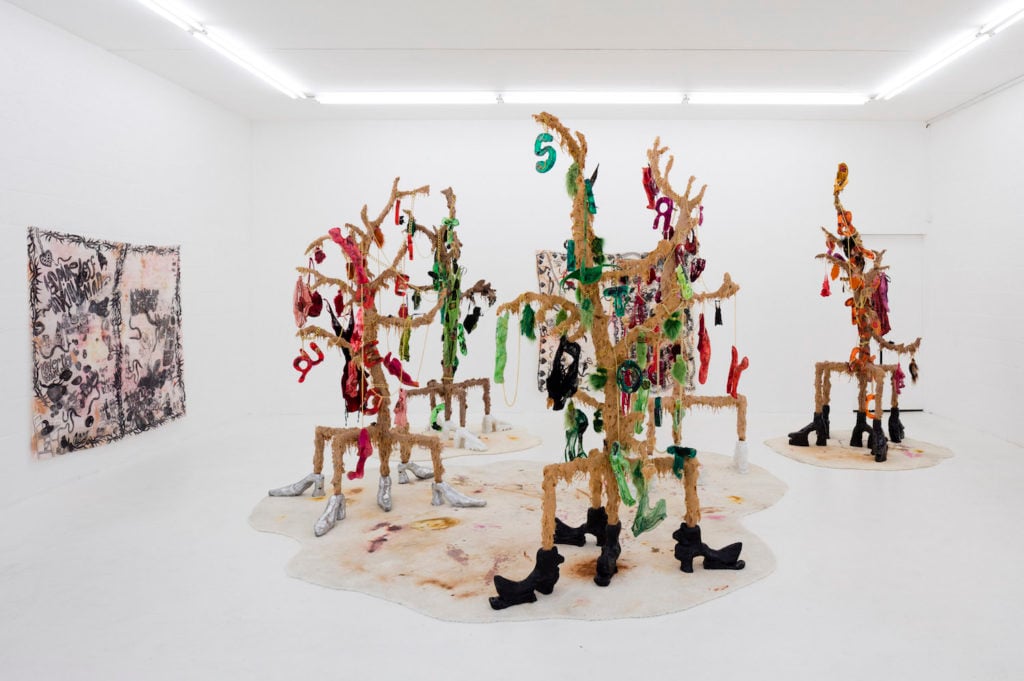
Installation view of Athena Papadopoulos’s exhibition “Smurfette” at Emalin London, 2017. Courtesy the gallery.
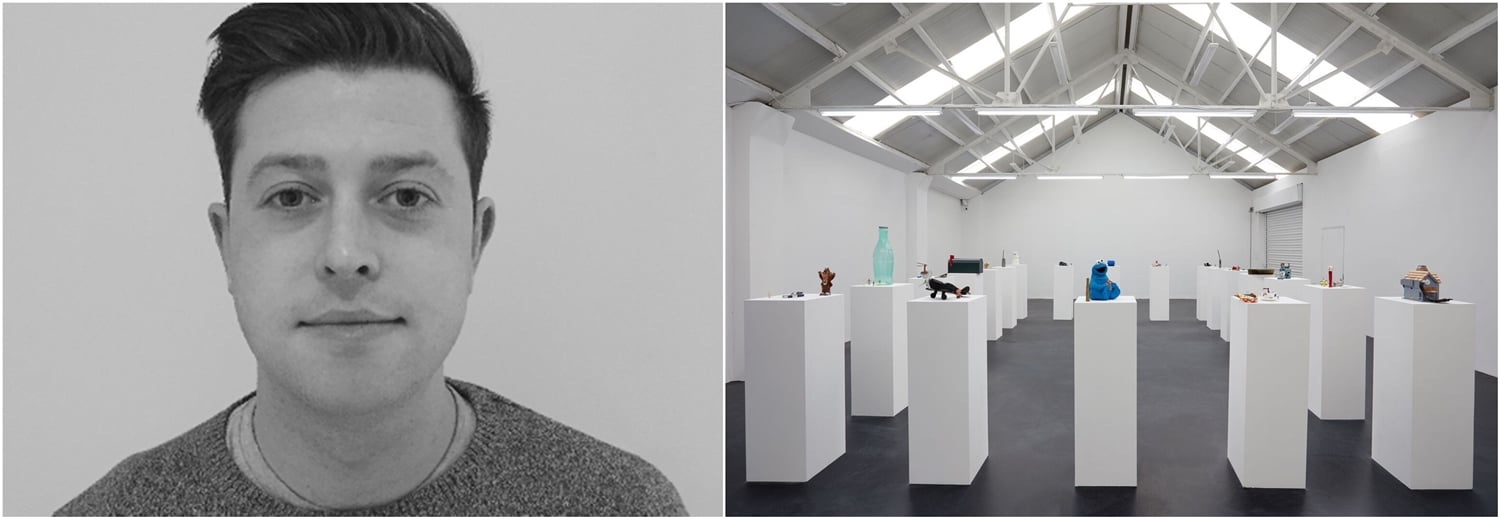
Jonathan Ellis King, of Ellis King Gallery; Installation view of Grear Patterson’s “Cereal Eater” show, 2017. Images courtesy of Ellis King Gallery.
Jonathan Ellis King opened his eponymous gallery in 2014, moving into the former site of a car garage in the heart of Dublin. Ellis King was the first to admit that the Irish city wasn’t exactly the epicenter of the international art scene, but while small galleries are shuttering in hub cities New York and London, Ellis King is thriving in its unconventional locale.
Ellis King has been in the throes of installing its most recent exhibition, a group show of about 30 artists, titled “Wormwood,” curated by Todd von Ammon of Team Gallery in New York’s Lower East Side. The ambitious project includes emerging artists from the gallery’s stable, including Ryan Estep and Chilean artist Pilar Quinteros (who will have her first solo exhibition later this year), along with top names like John Gerrard, Lynda Benglis, Sherrie Levine, and Donald Moffett.
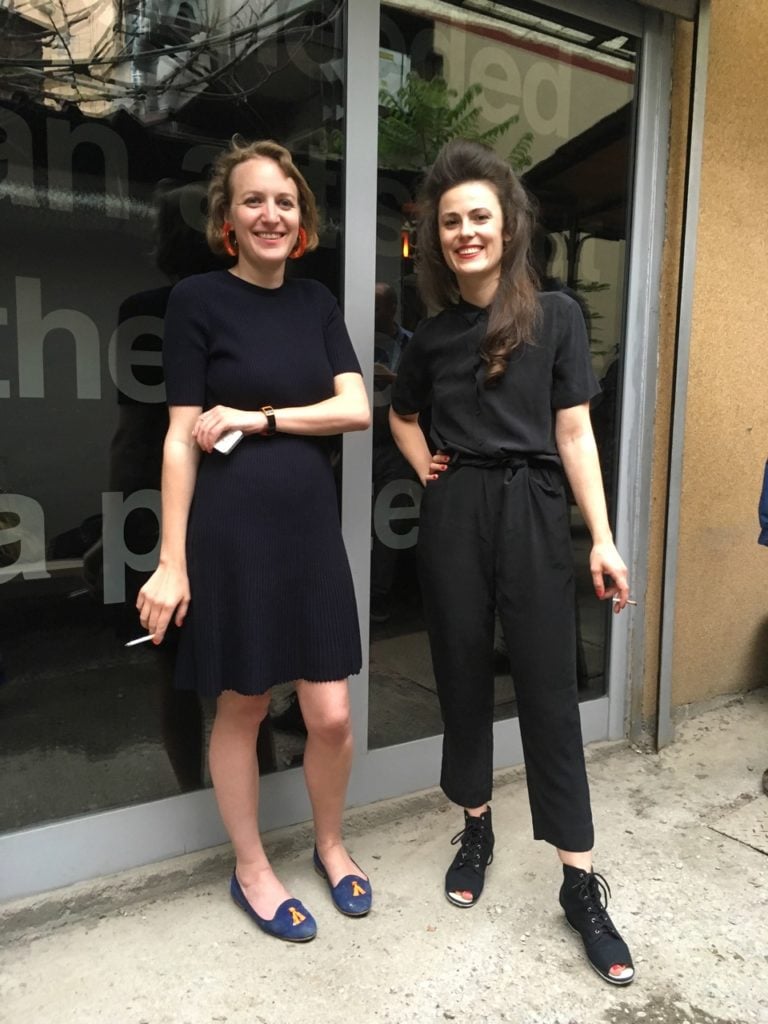
Katharina Schendl (left) and Isabella Ritter (right), the founders of LambdaLambdaLambda. Photo credit: Tina Herzl.
On a trip to Prishtina, Kosovo, in 2014, friends Katharina Schendl and Isabella Ritter visited a local bookstore only to find it had gone out of business. Less than a year later, that vacant storefront became home to their gallery, LambdaLambdaLambda.
The pair hadn’t always envisioned themselves as founders of one of Kosovo’s few contemporary art spaces. “It wasn’t really planned in a classical sense,” says Schendl, the founder of the web journal Footnotes on Art, and Ritter, an art historian. “The decision came very spontaneously. We fell in love with the youth, vibrancy, and people of the city.”
Over the past two years, the duo has built a program that puts the work of local artists in dialogue with other European names. In the process, they have helped to bring renewed attention to Kosovo’s art scene, which has remained somewhat isolated since the Kosovo War in the late 1990s.
In addition to regular art-fair participation, they invite outside curators to organize shows at the gallery and discover the work of local artists in situ. Next week, for example, LambdaLambdaLambda opens an exhibition curated by Elise Lammer of the Basel-based art nonprofit SALTS. The tactics seem to be paying off: Two new project spaces, Motrat and Passenger, opened in Prishtina this year. “There is good energy going around,” the duo says.
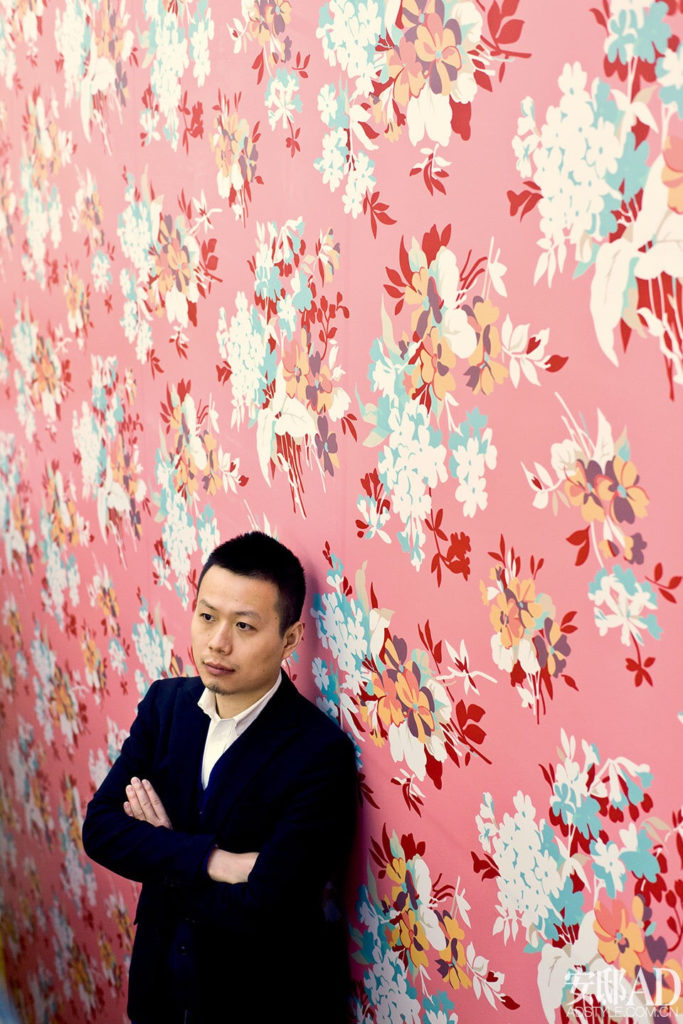
The art dealer Leo Xu in his Shanghai gallery.
In 2011, the young writer and curator Leo Xu read New Museum founder Marcia Tucker’s memoir A Short Life of Trouble and was so taken with her pledge to support “new art and new ideas” that he quit his job as James Cohan Gallery’s associate director in Shanghai and opened his own project space-slash-gallery in the city, with initial backing from the art entrepreneur David Chau.
Since then, the director—now 35—has built Leo Xu Projects into one of the most reliably boundary-marker-moving galleries in China, turning his three-story headquarters in Shanghai’s stately French Concession neighborhood into a hive of forward-thinking experimentation. Artists in the gallery include the provocative portrait photographer Pixy Liao (think Ryan McGinley, only female and Chinese), the conceptual wallpaperist Liu Shiyuan, the unsettling “SciTech” artist Xu Wenkai (who goes by aaajiao), acclaimed video artist Cheng Ran, and the in-demand painters Cui Jie and Li Qing.
“I was—and secretly am—an artist myself,” Xu says. “So I am particularly looking at artists who are uncompromising and truly challenge themselves to refine their language and redefine the boundary of their medium in their effort to engage with all the changes surrounding us.” In turn, the dealer is rethinking the gallery model itself, using his space as a base of operations but taking cues from design and architecture firms to produce custom-designed art programming for other venues as well, doing at least one pop-up show outside of China each year in addition to the normal regimen of art fairs.
“I don’t think a gallery today should limit its program to just one location, or only in its gallery spaces,” he says. This month, the gallery will have a show at Metro Pictures in New York as part of the citywide CONDO show.
What’s next for the gallery? Book publishing, says Xu, who is working on a project with the Beijing-based photographer Chen Wei, described as “a book that revisits and reimagines the club scene and rave cultures in China, since 1990s onwards.”

Nicole Russo.
Nicole Russo, a veteran of galleries like Leo Koenig and Jack Tilton, launched Chapter NY on New York’s Lower East Side in 2013, while still a director at Mitchell-Innes & Nash, running it on weekends only; she struck out on her own in 2015. Chapter is located on the parlor floor of a brownstone on East Houston Street, square in the mix with popular neighborhood venues like Rachel Uffner, Bureau, and Participant Inc.
Russo’s stable is a small cluster of 30-somethings like Sam Anderson, Cara Benedetto, Mira Dancy, and Willa Nasatir, who boast degrees like Yale and Columbia MFAs, and who, among them, have earned wall space at venues like New York’s Whitney Museum of American Art, Los Angeles’s Night Gallery, and Miami’s Rubell Family Art Collection.
But Russo’s most vital contribution might be the New York iteration of Condo, an initiative native to London in which young galleries used their spaces to host counterparts from cities all over the world. Russo and fellow Gotham dealer Simone Subal jump-started the New York version, in which dealers from cities as far-flung as Guatemala City, London, and Los Angeles briefly take up residence at Manhattan galleries. The project may provide a ground-level, gallery-to-gallery alternative to the growing challenge of showing at expensive art fairs that, for smaller galleries, may provide little return.
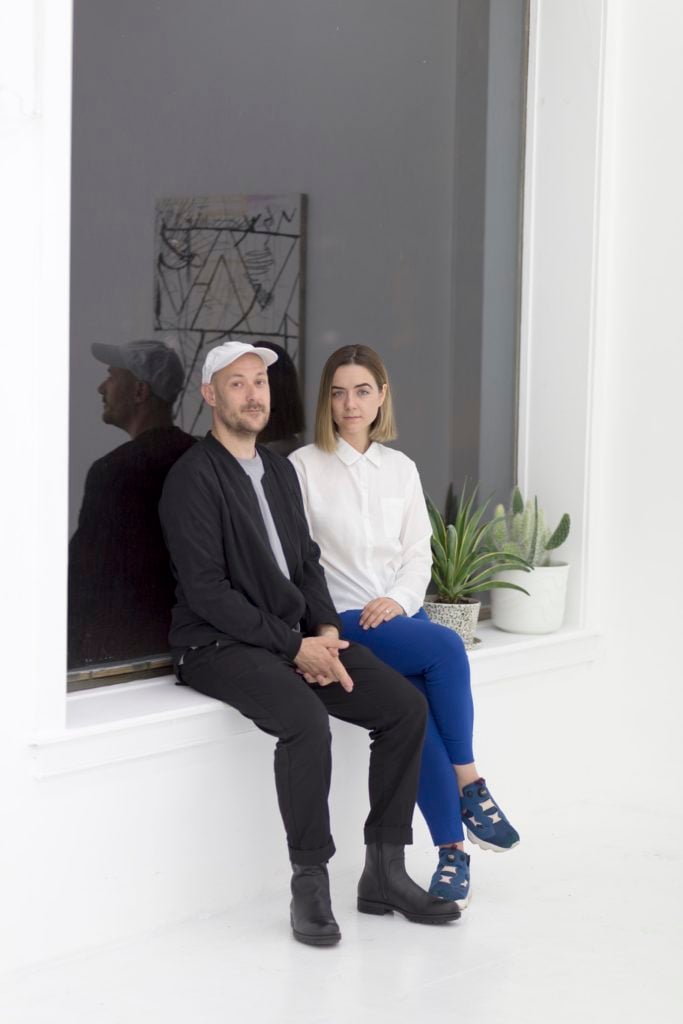
Amelia Szpiech and Hunter Bradley, of Springsteen. Image courtesy Springsteen.
Baltimore artists-turned-dealers Amelia Szpiech and Hunter Bradley opened an apartment gallery in 2013 with the goal of showcasing the local art scene. The operation has grown substantially over the years, and is now run out of a more traditional storefront, but still places an emphasis on the city both have called home for close to a decade.
“I think that’s what we do that’s most unique for Baltimore—we provide a specific professional context that brings artists from LA to Toronto to Tokyo to a small storefront on the on ramp of a highway, while also bringing Baltimore-based artists to fairs like NADA and Material,” the duo told artnet News in an email. “As we’ve grown, matured, [and] traveled, our roots in Baltimore have always been a grounding force and something we always come back to.”
Come fall, they are looking forward to a solo exhibition with New York-based artist Sydney Shen that promises to be “filled with mischief and humor.”
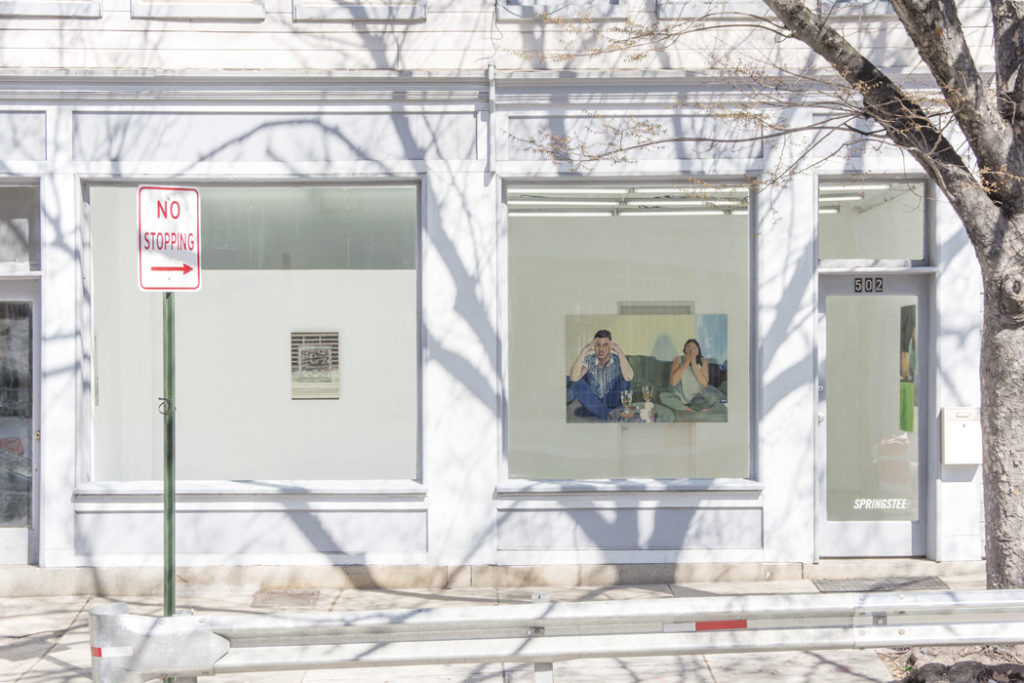
Work by Benjamin Horns, currently in the storefront of Springsteen. Image courtesy Springsteen.
Springsteen is located at 502 West Franklin Street, Baltimore, Maryland, and is open Saturdays, 1 p.m.–5 p.m. or by appointment.